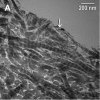Host-derived loss of dentin matrix stiffness associated with solubilization of collagen
- PMID: 19090493
- PMCID: PMC2694224
- DOI: 10.1002/jbm.b.31295
Host-derived loss of dentin matrix stiffness associated with solubilization of collagen
Abstract
Matrix metalloproteinases (MMPs) bound to dentin matrices are activated during adhesive bonding procedures and are thought to contribute to the progressive degradation of resin-dentin bonds over time. The purpose of this study was to evaluate the changes in mechanical, biochemical, and structural properties of demineralized dentin treated with or without chlorhexidine (CHX), a known MMP-inhibitor. After demineralizing dentin beams in EDTA or phosphoric acid (PA), the baseline modulus of elasticity (E) of each beam was measured by three-point flexure. Specimens were pretreated with water (control) or with 2% CHX (experimental) and then incubated in artificial saliva (AS) at 37 degrees C for 4 weeks. The E of each specimen was remeasured weekly and, the media was analyzed for solubilized dentin collagen at first and fourth week of incubation. Some specimens were processed for electron microscopy (TEM) immediately after demineralization and after 4 weeks of incubation. In EDTA and PA-demineralized specimens, the E of the control specimens fell (p < 0.05) after incubation in AS, whereas there were no changes in E of the CHX-pretreated specimens over time. More collagen was solubilized from PA-demineralized controls (p < 0.05) than from EDTA-demineralized matrices after 1 or 4 weeks. Less collagen (p < 0.05) was solubilized from CHX-pretreated specimens demineralized in EDTA compared with PA. TEM examination of control beams revealed that prolonged demineralization of dentin in 10% PA (12 h) did not denature the collagen fibrils.
(c) 2008 Wiley Periodicals, Inc.
Figures







References
-
- Marshall GW, Jr, Marshall SJ, Kinney JH, Balooch M. The dentin substrate: structure and properties related to bonding. J Dent. 1997;25(6):441–58. - PubMed
-
- Kinney JHJ, Pople A, Marshall GW, Marshall SJ. Collagen orientation and crystallite size in human dentin: a small angle X-ray scattering study. Calcif Tissue Int. 2001;69(1):31–7. - PubMed
-
- Miguez PA, Pereira PN, Atsawasuwan P, Yamauchi M. Collagen cross-linking and ultimate tensile strength in dentin. J Dent Res. 2004;83(10):807–10. - PubMed
-
- Schlueter RJ, Veis A. The macromolecular organization of dentin matrix collagen. I. Periodate degradation and carbohydrate cross-linking. Biochemistry. 1964;3:1657–65. - PubMed
Publication types
MeSH terms
Substances
Grants and funding
LinkOut - more resources
Full Text Sources
Other Literature Sources
Research Materials

